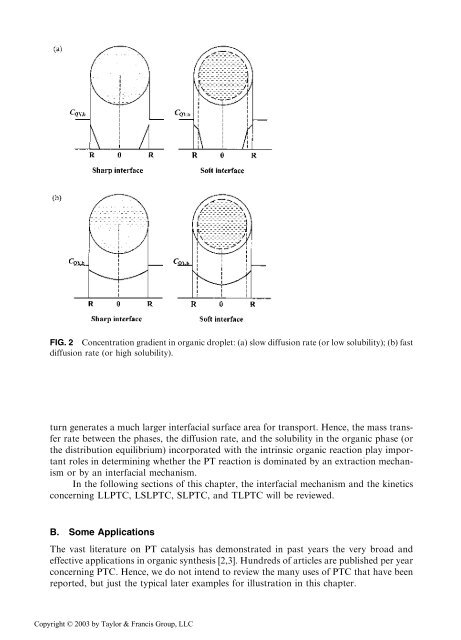FIG. 2 Concentration gradient in organic droplet: (a) slow diffusion rate (or low solubility); (b) fastdiffusion rate (or high solubility).turn generates a much larger interfacial surface area for transport. Hence, the mass transferrate between the phases, the diffusion rate, <strong>and</strong> the solubility in the organic phase (orthe distribution equilibrium) incorporated with the intrinsic organic reaction play importantroles in determining whether the PT reaction is dominated by an extraction mechanismor by an interfacial mechanism.In the following sections <strong>of</strong> this chapter, the interfacial mechanism <strong>and</strong> the kineticsconcerning LLPTC, LSLPTC, SLPTC, <strong>and</strong> TLPTC will be reviewed.B. Some ApplicationsThe vast literature on PT catalysis has demonstrated in past years the very broad <strong>and</strong>effective applications in organic synthesis [2,3]. Hundreds <strong>of</strong> articles are published per yearconcerning PTC. Hence, we do not intend to review the many uses <strong>of</strong> PTC that have beenreported, but just the typical later examples for illustration in this chapter.Copyright © 2003 by Taylor & Francis Group, LLC
1. Applications in BiologyOrsini et al. [4] synthesized biologically polyphenolic glycosides via Wittig reactions followedby glucosylation under PT conditions. These compounds include (E)-3-(-d-glucopyranosyloxy)-40 ,5-dihydroxystilbene (resveratrol 3--d-glucoside, piceid), (Z)-2 0 ,3 0 -dihydroxy-3,4,4 0 5-tetramethoxystilbene (combretastatin A-1), ;-dihydro-2 0 ,3 0 -dihydroxy-3,4,40 ,5-tetramethoxystilbene (combretastatin B-1), etc. Under PTC, the glucosylationis stereoselective <strong>and</strong> gives the best results for yields with benzyltriethylammoniumchloride <strong>and</strong> aqueous sodium hydroxide. The use <strong>of</strong> nonaqueous bases in dry solventsleads to a sluggish reaction at room temperature, probably due to the poor solubility <strong>of</strong>the phenolate ion in the solvents. Carrie` re et al. [5] synthesized O-, S-, Se-, <strong>and</strong> C-glycosidesby PTC. For the synthesis <strong>of</strong> O-glycosides under liquid–liquid conditions, usingdichloromethane as the organic solvent <strong>and</strong> aqueous NaOH as the base, the PT catalysttetrabutylammonium hydrogen sulfate is used to avoid the possibility <strong>of</strong> double halidedisplacement. PTC conditions are successfully applied in the synthesis <strong>of</strong> - <strong>and</strong> -naphthols to glycohydrolase substrate 7-hydroxy-4-methylcoumarin, to chromogenic substrateFat Brown B 1 , <strong>and</strong> to estrone prodrug. In the preparation <strong>of</strong> thio- <strong>and</strong> selenoglycosides,having saturated NAHCO 3 <strong>and</strong> 1 M Na 2 CO 3 as the aqueous base is sufficientwith thiols <strong>and</strong> selenols, <strong>and</strong> together with tetrabutylammonium hydrogen sulfate as thecatalyst, <strong>and</strong> ethyl acetate as the solvent instead <strong>of</strong> dichloromethane, whereby the sideproducts are produced.Albanese et al. [6] reported the synthesis <strong>of</strong> 2-substituted 3,4-dihydro-2H-1,4-benzoxazinesby ring opening <strong>of</strong> glycidols under solid–liquid PTC. They used N-(2-fluorophenyl)toluene-p-sulfonamideas the nitrogen nucleophile by incorporating the aromaticmoiety <strong>of</strong> benzoxazine as the leaving group, <strong>and</strong> performed the ring opening by stirring at90 C a heterogeneous mixture <strong>of</strong> 1,2-epoxy-3-phenoxypropane, sulfonamide, anhydrousK 2 CO 3 , the catalyst BzEt 3 NCl, <strong>and</strong> dioxane to produce a 95% yield <strong>of</strong> N-(2-fluorophenyl)-N-(2-hydroxy-propyl)toluene-p-sulfonamideafter 17 h <strong>of</strong> reaction. This method providesa straightforward <strong>and</strong> new approach to the synthesis <strong>of</strong> chiral 2-substituted 3,4-dihydro-2H-1,4-benzoxazines.Asymmetric PTC is an important method in the synthesis <strong>of</strong> -alkyl <strong>and</strong> -aminoacids. Belokon et al. [7] reported that the compound (4R,5R)-2,2-dimethyl-;; 0 ; 0 -tetraphenyl-1,3-dioxolane-4,5-dimethanol(TADDOL) was used to catalyze the C-alkylation <strong>of</strong>C–H acids with alkyl halides to the asymmetric synthesis <strong>of</strong> -methyl-substituted -aminoacids under PTC conditions. The alkylations <strong>of</strong> the substrate C–H acids with benzylbromide or allyl bromide were conducted in dry toluene at ambient temperature withNaH or solid NaOH as base <strong>and</strong> TADDOL as a chiral promoter. The type <strong>of</strong> base isimportant in the asymmetric C-alkylation <strong>of</strong> C–H acids.Lygo et al. [8] investigated the enantioselective synthesis <strong>of</strong> bis--amino acid estersvia asymmetric PTC. Under liquid–liquid conditions, the target amino acid esters wereobtained with high enantiometric excess ( 95% ee) from the alkylation reaction <strong>of</strong> benzophenone-derivedglycineimine with an appropriate dibromide. They reported that eitherthe mono- or di-alkylated product could be obtained, depending on the reaction conditions;the monoalkylated product was obtained in good yield with excess dibromide,whereas with stoichiometric quantities <strong>of</strong> dibromide this led to the dialkylated product.By controlling the stoichiometry <strong>of</strong> the reaction, the selectivity <strong>of</strong> the desired product canbe accessed at a high level. Lygo et al. [9] also reported the asymmetric synthesis <strong>of</strong> bis-aminoacids via alkylation <strong>of</strong> a benzophenone-derived glycineimine under PTC conditions.The target bisamino acids can be produced with high yields <strong>and</strong> high levels <strong>of</strong> stereoselectivityby applying chiral quaternary ammonium salts. The core structure <strong>of</strong> the chiralCopyright © 2003 by Taylor & Francis Group, LLC
















